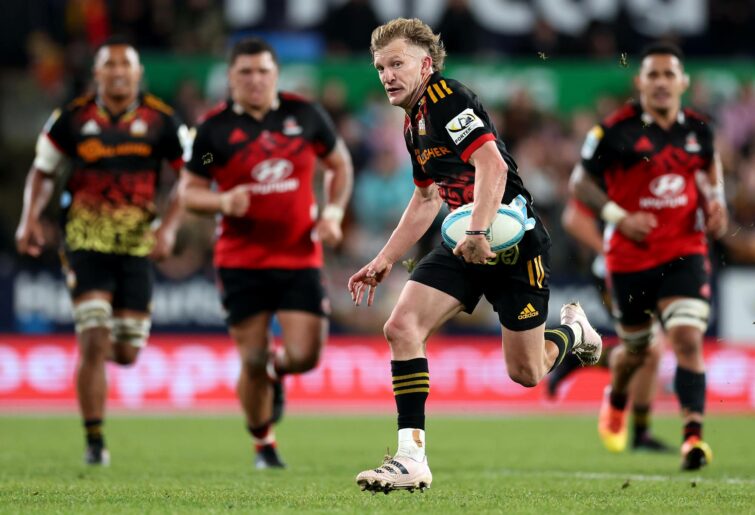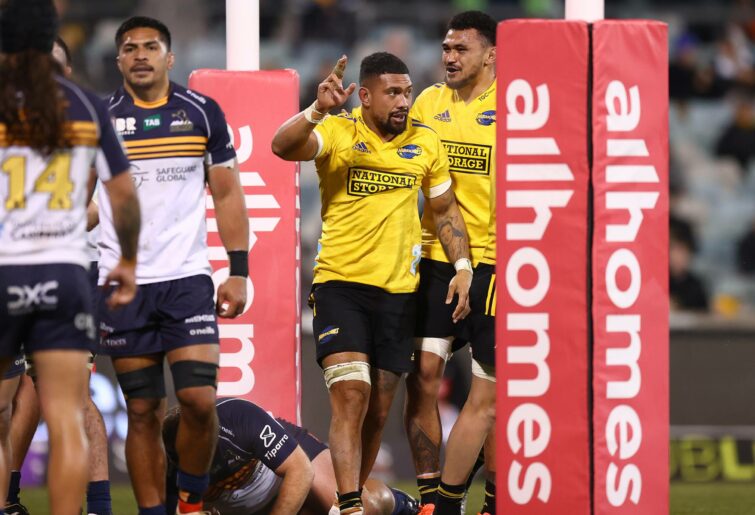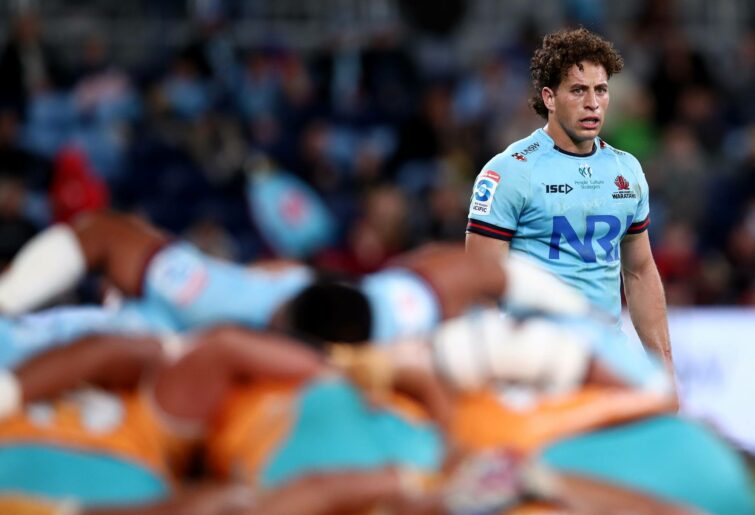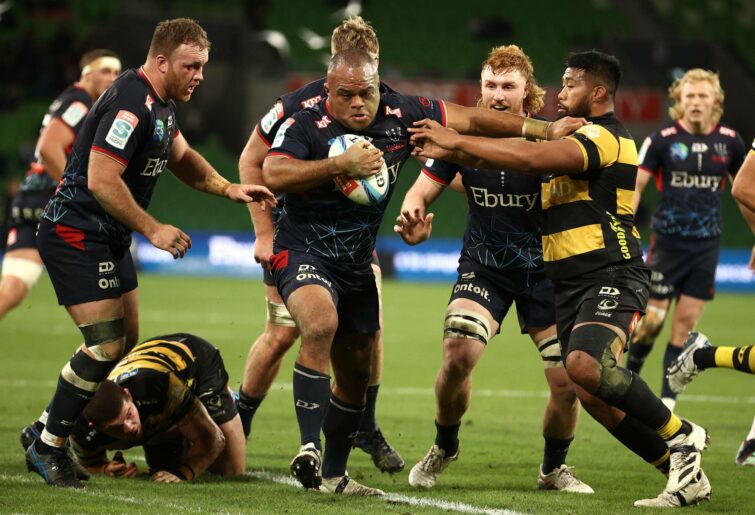Progress is slowly happening: What each of our Aussie Super Rugby teams must do to take the next step
There is a lot of hope around the country, but there's so much more work still to be done.
Opinion
Helmuth von Moltke once wrote that “No plan of operations extends with any certainty beyond the first encounter with enemy forces”, nonetheless so much of professional rugby today is centred around developing structures to beat opponents.
Wallabies Coach Eddie Jones’ recently claimed 75 percent of tries are scored within three phases, a stat he promises will dictate the Wallabies’ own attack. Yet, in the first encounters with enemy forces, the Wallabies have been hammered in Pretoria and ambushed at home.
The 2023 Super Rugby Pacific season is over, with the two finalists defined by contrasting attacking styles. Despite a shaky start, the Crusaders built momentum through the season relying on a combination of set-piece superiority and intelligent back strikes.
Meanwhile the Chiefs had looked the best side all season defined by long-range strike capability. In Super Rugby Pacific 2023, the rate of tries based on three phases was actually 61.70%, but phase count is often more indicative of style rather than success.

Damian McKenzie of the Chiefs (Photo by Phil Walter/Getty Images)
The distinctive styles of the two finalists begs the question — how do different sides score points, and do successful sides have particular characteristics that can be replicated?
An analysis of every Super Rugby Pacific try scored in 2023 highlight distinct trends in how SR sides attacked, both successfully and not so much.
Teams can be broadly categorised by playing style based on how they score points. Ultimately, attacking rugby can only be structured to a point.
Collisions mean that sometimes individuals can make poor plans work or good plans fail. Yet, the attacking trends of teams can help to highlight what underlying aims are, making it easier to justify or question coaches’ plans.
Long Range Strikers such as the Chiefs and Hurricanes generally relied on scoring tries from outside the 22 and from broken play. The Crusaders, Brumbies and Pasifika instead emphasised forward and set-piece dominance to create a platform to attack.
These teams scored from closer range and built pressure through territory. Others were halfback-centric, such as the Reds, Highlanders and Force, whose halfbacks’ unique styles dictated play and their sides’ attacking opportunities.
The Chiefs relied heavily on their dangerous attacking backline, starting their try scoring attacks at an average distance of 35.71 metres, the furthest among all teams in the competition. They scored the highest percentage of tries (31.43%) from attacks originating in their own half.
The Chiefs were not alone in their long-range approach, with the Hurricanes and Blues ranking 2nd and 3rd in the distance playing a similar style of broken play attack.
The exceptional potency of the Chiefs’ attack set them apart from the rest, as evidenced by their seventh-place ranking in scoring tries off more than four phases, with just 27.14%. In contrast, the Hurricanes and Blues ranked second and third, with 39.73% and 38.81% of their tries coming from more than four phases.
Consequently, while the Blues and Hurricanes had to be patient in their long-range attacks with more effort for ball security, the Chiefs scored faster when attacking — diminishing the risk of turnover in each attacking raid.
Much like the Chiefs, the Blues used their extensive backline talent such as Beauden Barrett, Mark Telea, and Rieko Ioane to threaten teams when outside the 22. They scored the second most tries from outside the 22 and had the most passes per try in the competition at 6.13.
They also were more effective than most playing centrally, with the second-highest percentage of tries coming between the 15m channels (55.22%).
On the downside, just 47.76% of Blues tries landed in three or less phases. This rate was the worst in the competition, and highlights that the Blues had to work harder for their tries than most teams.
The Blues had to sustain attack for many phases before players like Mark Telea, who was number one in the competition for clean breaks and defenders beaten, could win matchups.
The Hurricanes interestingly scored the most tries per game with an average of 4.86. The Canes drew on a combination of efficiency attacking from range and individual brilliance.
While the Chiefs and Blues relied on their back three breaking the line, the Hurricanes were more focused on an offload strategy with 11.47 offloads per game (highest in the competition), involving a range of positions.
Athletic backrowers including Devan Flanders, Ardie Savea, Du’Plessis Kirifi, Peter Lakai, and Brayden Iose frequently integrated with the backs to create long range options.

Ardie Savea of the Hurricanes. (Photo by Mark Nolan/Getty Images)
The Fijian Drua played a similar game style to the Hurricanes but with a unique flair that promoted longer-range scoring across all positions and a high-tempo attack. Along with the Chiefs, the Drua had the fewest tries scored from conventional set-piece (scrums and lineouts) at 50.91%. However, in contrast to the Hurricanes, the Drua had the lowest phases per try in the competition at just 2.93.

Kalaveti Ravouvou of the Fijian Drua. (Photo by Bradley Kanaris/Getty Images)
This manifested in the lowest same zone finishes (where a team scores in the same channel where the attack started) in the competition at 23.63%, because they often focused on immediately moving the ball to space, rather than breaking down a defensive structure through sustained pressure.
Like the Chiefs, the Drua targeted broken defences but with less reliance on individual brilliance and instead on fast-paced team intent. The Drua were second in tries scored off quick taps (12.7%) with a variety of players involved, testing off-guard defences.
The Chiefs’ ability to strike from deep and strike fast, delivered plenty of tries from kick returns (20%) and stolen ball (27.14%), a combined highest in the competition.
Additionally, they were the most willing to use attacking kicks to score, with 20% of tries scored involving a grubber, cross-field, or chip kick. Their backline, featuring players like Damian Mackenzie, Shaun Stevenson, and Emoni Narawa capitalised on their counterattacking capability, exploiting fragmented defences on turnover ball.
While this approach proved ruthlessly effective for much of the season, with their backline always posing a threat, the Chiefs scored fewer tries (31.43%) from attacks starting in the opposition’s 22, ranking last in the competition.
The Chiefs’ long-range approach is dependent on the continued presence of exceptional individuals who can make their system work.
Contrasting the Chiefs’ high-energy, long-range attack are the consistently successful Crusaders and Brumbies. Both teams have similar scoring patterns and team makeup with forward dominance underpinning their attack.
The Crusaders rank second in tries per game (4.76), third in attack distance (21.98m), and fifth in average phases to score (3.17). On the other hand, the Brumbies rank third in tries per game (4.44), fifth in attack distance (22.51m), and third in average phases to score (3.11).
Both teams lean on their driving mauls, which are the two best in the competition. The Crusaders scored almost a quarter of their tries from mauls, while the Brumbies scored nearly a fifth.
This formula begins with winning territory then applying pressure based on try-line proximity. First-phase tries are a hallmark of this approach, with 50.7% of the Brumbies’ tries (ranking 1st) and 48.15% of all Crusaders’ tries (ranking 2nd) coming from the first phase.
Set-piece dominance also allows these teams to execute well-planned strike moves directly from lineouts. This approach set them apart in the competition, allowing their backlines more opportunity for ‘home-run strikes’ and creating favourable matchups.
One such player who benefitted from this approach was Leicester Fainga’anuku, who scored seven tries on first-phase set moves off either scrum or lineout, with plays designed around creating space and matchups for him. The only player in the competition who might have had more influence on their team’s first-phase attack than Fainga’anuku is Levi Aumua of Moana Pasifika.
Aumua was one of the most damaging ball-carriers in the comp, able to create favourable matchups for others just through his mere presence. It does not seem like a coincidence that after Fainga’anuku left the Crusaders for Toulon, Aumua has now signed with the Crusaders as his replacement.
A notable difference between the Crusaders and the Brumbies lies in their pitch spread balance. The Crusaders score across the entire field, while the Brumbies heavily rely on Corey Toole, an individual player to create attacking opportunities.
The Brumbies show a significant disparity in scoring location on the wings, with 43.67% of their scores on the left wing (touchline to 15m line) and only 14.01% on the right wing.
While teams typically have a slightly higher concentration on the left wing as the stronger passing and kicking side for right-handed players, the average difference across the competition is 7.36%.
Moana Pasifika, despite notching only one win in 2023, were the team that most closely emulated the Crusaders and Brumbies style of first-phase scoring dominance. They were third in the competition in try-scoring mauls and first phase try-scoring, and second in the competition in tries started in the 22 (70%).

Christian Leali’ifano of Moana Pasifika (Photo by Hannah Peters/Getty Images)
This is in large part due to the threat of Levi Aumua, the shining star in the underwhelming junior franchise. Aumua scored four tries from first phase set plays and further tilted the defence away leaving Christian Leali’ifano to score two other tries from dummy passes aimed at Aumua. A fear of rampaging Aumua and his teammate Timoci Tavatavanawi frequently saw oppositions opting to defend the dangerous ballcarriers and leave mauls less contested.
The one key differentiator between Pasifika and the more successful teams is their scoring opportunities, as they averaged 0.8 tries per game less than the Brumbies.
Pasifika often lacked direction and strategy to manipulate defences on non-set piece other than the often-incredible Aumua carries. Aumua and Tavatavanawi’s departures from Pasifika will seriously hurt Pasifika’s growth and success. Pasifika’s loss is the Crusaders’ gain.
Halfbacks were the most common individual players to build systems around such as the Reds’ Tate McDermott who’s running threat permeated his team’s attack. McDermott’s sniping promotes a more central attack, resulting in the Reds topping the tries scored between the posts at 17.54%.
The Reds stood out with the lowest average passes per try in the competition at 3.5, with increased willingness to play off 9 rather than 10 and pick and go when in the 22. The other notable feature of the Reds attack was their ineffective scrum. The Reds scored just 3.44% of tries off their scrum, a distant last in the competition with their scrum win percentage just 75% (also lowest in the comp).
Their scrum was noticeably missing the presence of Taniela Tupou throughout the season. Oppositions didn’t miss the memo, allowing their flankers to disengage and more effectively defend against the Reds’ scrum plays. Their inability to utilise the scrum in attack undermined their dangerous individual players.
Running halfbacks across the competition like McDermott influenced attacks and allowed teams to behave unconventionally by more often targeting space near rucks rather than on edges. The Force were one such team with Isaac Fines-Leleiwasa’s speed allowing the Perth team to adopt a distinct attacking style.
The Force struggled to score tries in 2023, with the lowest tries per game (3.29) and the highest phases per try (4.59). Despite an underwhelming attack, Fines-Leleiwasa was clearly the focal-point, having the fourth-most try assists in the competition at 8 and was particularly impactful in propelling the Force to number one in tries scored from quick taps (19.57%).
The average figure for the rest of the competition was 6.1%, with the Force often relying on Fines-Leleiwasa’s speed and vision for gaps to create attacking spark. The Force’s strategic shift in recruiting Nic White for 2024 is intriguing given Fines-Leleiwasa was one of their best.
The Highlanders, perhaps the team most influenced by a distributor, were a different side when halfback Aaron Smith played. When Smith played (9 of 14 games), they averaged 4 tries per game (would be seventh amongst the comp), but when he didn’t, they only averaged 2.4 (0.88 and worse than the last in comp).
This 1.6 try difference can be nearly entirely attributed to Smith, who was first in the competition in try assists (1.4 per game) and also averaged 0.3 tries per game. Interestingly, the accompanying attacking stats for the Highlanders are not dramatically different when Smith did not play.
Essentially, the Highlanders changed little about their play style, only their halfback and their attack dramatically improved. This reliance on Smith’s brilliance should concern the Highlanders for 2024 with his departure likely the most significant in the competition.
Finally, are the teams searching for an identity: the Rebels and Waratahs. Both attacks were promising with game-breaking young talent but lacked a killer instinct and clear strengths that fans may have hoped for. The Waratahs found themselves middling in all statistics: eighth in tries per game (3.73), seventh in average distance to score, and an encouraging (but not sensational) fourth in tries off first phase (41.07%).
They possessed a proficient lineout, maul, and scrum, but lacked a distinctive offensive weapon. The Tahs’ attack was functional but not special. While such an attack might suffice for a team like the Force, which lacked a wealth of individual talent, it seemed inadequate for a team endowed with international players and rising stars like Langi Gleeson and Max Jorgensen.
Given the talent on the roster, fans had higher expectations.
An area of Waratahs’ effectiveness was on kick returns, scoring 14.29% of their tries from these, the fourth most in the competition. For a team that played such a structured game, it seems counter-intuitive. However, these kick returns often provided brief glimpses of a potent backline threat that never quite materialised.
Interestingly, the Waratahs were the most one-sided attack in the competition, with 66.07% of tries being scored left of the posts. This is particularly surprising given Wallaby Mark Nawaqanitawase was their right winger. Nawaqanitawase had the most defenders beaten by an Australian player with 47 and scored 8 tries in 2023.

Mark Nawaqanitawase of the Waratahs (Photo by Jason McCawley/Getty Images)
However, most of the Waratahs’ first phase tries were scored on the left wing, whether by design or simply better execution it was an interesting tilt away from a star player.
Despite showing promise, the Waratahs struggled under the heavy expectations following an encouraging 2022 season. Even though they maintained the same sixth position on the ladder at the end of both seasons, their performance in 2023 was seen as a letdown.
An initial optimism that promising players would develop further — leading to a more dynamic attacking system — proved unfounded. With additional time in 2024 to develop a more complete attacking style and allow for player maturity, the Waratahs could be more formidable.
In a similar vein, the Rebels were a team whose reality didn’t match expectations. The Rebels played exciting attacking rugby and often looked like the second-best Australian side, but by the end of the season were once again in 11th place.
They finished sixth in tries per game at 4.07 and much like the Waratahs, lacked a clear attacking platform. Instead, the emerging dynamo Carter Gordon often sparked magic with some inspiring play.
The Rebels drew on Gordon’s ability and willingness to play at the gain line, to create go-forward and pressure defences. Consequently, they had the fourth lowest passes per try with 4.32, as Gordon’s combative nature often meant a single cut-out ball or offload would break defences.
This was enormously promising for the Rebels, but the lack of support behind Gordon at times meant the Rebels were not sufficiently clinical in tight games. Despite leading in the second half of nine games, the Rebels were only victorious in four.
Put plainly, poor decision-making was behind the Rebels’ inability to execute effectively, despite some promising passages of play.

Sam Talakai of the Rebels (Photo by Robert Cianflone/Getty Images)
The Rebels held the dubious distinction of being the team with the fewest tries scored off quick-taps in the competition — managing just one such score throughout the year.
Ignoring the warning signs, the Rebels chose the low-odds quick tap near the line all too frequently — most notably three times unsuccessfully in the final 10 minutes against the Brumbies in round 11, when they trailed by seven points. This behaviour highlighted a more pervasive issue for the Rebels.
While their set-piece was reasonably competent, they lacked confidence in both their scrum and lineout during critical moments. If the Rebels want to be more successful in the future, this pattern needs to change.
The Rebels appeared most effective during kick returns when they could take advantage of less established defenses. Gordon’s aggressive attacking style was particularly successful in such situations, with the Rebels’ kick return tries averaging 4.22 phases from 49 metres out.
Going forward, the Rebels should focus attention on their scrum and lineout capabilities to exert more pressure on opponents’ defenses, aiming to replicate the scenarios they often face during kick returns. Such a strategic shift would better leverage their flyhalf’s strengths and bolster overall offensive performance.
The high-profile acquisitions of Taniela Tupou and Lukhan Salakaia-Loto in 2024 are promising. These signings may provide the much-needed improvements in the Rebels’ forward pack, adding potency to set-pieces, and ballast to the attack strategy.
The 2023 Super Rugby season was one which saw a wide range of game styles contend, with the most effective teams being those who had a strong identity and knew what they were good at. In 2024, teams attacking strategies will likely be defined by their departures and arrivals post Rugby World Cup.
Teams such as the Chiefs and Brumbies will have star halfbacks leave but will otherwise retain a stable squad and will likely continue to improve and evolve their attacking plan.
Other teams such as Moana Pasifika, which are losing their two best players in Levi Aumua and Timoci Tavatavanawi, and the Highlanders — whose central cog Aaron Smith is departing ¬— will face challenges in filling the gaps.